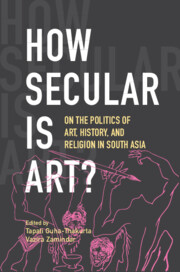11 - Re-enchanting Mughal Architecture: A Critique of the Secular Disenchantment of India’s Past
Published online by Cambridge University Press: 21 February 2023
Summary
In the fall of 2017, the Taj Mahal (Image 11.1) made international news once again. This time it was not due to pollution, or its sectarian registration as a Muslim cemetery, or tourism development schemes, but because the state government of Uttar Pradesh, controlled by the Hindu nationalist Bharatiya Janata Party (Indian People’s Party, commonly known as the BJP), removed it from its tourism brochure. This removal was the final incident in a series of public actions, and the one that gained global media attention. Earlier in the year, the newly elected Hindu nationalist chief minister Yogi Adityanath claimed in a speech that the Taj did not represent Indian culture. This statement was followed by the BJP legislator Sangeet Som’s public claim that the Taj Mahal was a ‘blot’ on India’s culture and built by traitors, which then led BJP leader Vinay Katiyar to resuscitate the theory that the tomb was once a temple dedicated to the Hindu god Shiva. These actions were by no means the first challenge to the Taj Mahal’s existence as a monument of Mughal achievement. The first case of disrespect was reported in 1830 when the first governor general of India Lord Bentinck wanted to dismantle the tomb and sell its marble at the going market rate. The story was never corroborated by eyewitnesses or written evidence but with every retelling it signalled the colonial approach to land management and the East India Company’s desire to turn its territories, along with their monuments, into profitable holding. Fanny Parks, the wife of an East India Company clerk, who sympathized with the Mughals, wrote in her travel diaries against the wanton destruction of their monuments in the name of profit. After she cites the article about Bentinck’s scheme in the Calcutta newspaper John Bull, she asks: ‘If this be true, is it not shameful? … By what authority does the Governor-general offer the taj for sale? Has he any right to molest the dead? To sell the tomb raised over an empress, which from its extraordinary beauty is the wonder of the world?’ When Parks’s diaries were published in 1850 in London her writings represented an early challenge to the East India Company’s valuing of India’s Mughal monuments for no more than their raw material.
- Type
- Chapter
- Information
- How Secular Is Art?On the Politics of Art, History and Religion in South Asia, pp. 333 - 352Publisher: Cambridge University PressPrint publication year: 2024



